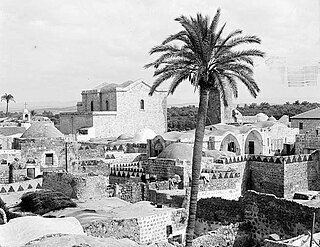Rama is the legendary Indian king regarded as an incarnation of Vishnu.
Apamea or Apameia is the name of several Hellenistic cities in western Asia, after Apama, the Sogdian wife of Seleucus I Nicator, several of which are also former bishoprics and Catholic titular see.
Delkos, or Delcus, was a town of ancient Thrace. Under the name of Delcus it was a bishopric and later a titular see, now suppressed, of the Roman Catholic Church. It later called Dercos, under which name it again was a bishopric and later a titular see of the Roman Catholic Church. The Orthodox diocese remains extant.
The Vicariate Apostolic of Northern Germany, known for most of its existence as the Vicariate Apostolic of the NorthernMissions, was a Catholic missionary jurisdiction established on 28 April 1667. It belonged to a vicar apostolic in predominantly Protestant Northern Europe.

The Bishopric of the Forces is a Latin Church military ordinariate of the Catholic Church which provides chaplains to the British Armed Forces based in the United Kingdom and their overseas postings.

Nyssa was a small town and bishopric in Cappadocia, Asia Minor. It is important in the history of Christianity due to being the see of the prominent 4th century bishop Gregory of Nyssa. Today, its name continues to be used as a titular see in the Eastern Orthodox Church and the Roman Catholic Church.

Diocese of Lydda (Lod) is one of the oldest bishoprics of the early Christian Church in the Holy Land. Suppressed under Persian and Arab-Islamic rule, it was revived by the Crusaders and remains a Latin Catholic titular see.
Motella, Metello(u)polis, or Pulcherianopolis was a city in the Roman province of Phrygia Pacatiana, in Asia Minor, probably on the site of the modern Yeşiloba (Medele).
Cotenna or Kotenna was a city in the Roman province of Pamphylia I in Asia Minor. It corresponds to modern Gödene, near Konya, Turkey.
Traianopolis, Trajanopolis, Tranopolis, or Tranupolis was a Roman and Byzantine city in Phrygia Pacatiana Prima.
Palaeopolis in Pamphylia was an Ancient city and bishopric in Asia Minor, and is a Catholic episcopal titular see.
Dionysiopolis or Dionysopolis, was a city of Phrygia in Asia Minor. The demonym Dionysopolitae (Διονυσοπολίτης) occurs on medals, and in a letter of M. Cicero to his brother Quintus, in which he speaks of the people of Dionysopolis being very hostile to Quintus, which must have been for something that Quintus did during his praetorship of Asia. Pliny places the Dionysopolitae in the conventus of Apamea, which is all the ancient writers note of their position. We may infer from the coin that the place was on the Maeander, or near it. Stephanus of Byzantium says that it was founded by Attalus and Eumenes. Stephanus mentions another Dionysopolis in Pontus, originally called Cruni, and he quotes two verses of Scymnus about it; however, the town of Dionysupolis in Thrace but on the Pontus, rather than in Pontus could be meant.
Colonia or Koloneia, also called Colonia in Armenia to distinguish it from other towns of the same name, was a town of ancient Lesser Armenia, inhabited during Hellenistic, Roman, and Byzantine times. It became important enough to be the seat of a bishop, a suffragan in the Late Roman Province of Armenia Prima, but faded like most in Asia Minor. No longer a residential bishopric, it remains, under the name Colonia in Armenia, a titular see of the Roman Catholic Church.

Satala or Satala in Lydia was a Roman era city and Bishopric in ancient Lydia.
Limnae (in Pisidia) was a city and bishopric in the Roman province of Pisidia (Asia Minor), which is now a Latin Catholic titular see.
Baris, called Baris in Hellesponto to distinguish it from other places called Baris, was an ancient city and bishopric in Asia Minor, which remains a Catholic titular see.
Catholic dioceses in the Holy Land and Cyprus is a multi-rite, international episcopate in Israel and Cyprus.
Ceretapa or Keretapa, also called Diocaesarea or Diocaesareia or Diokaisareia (Διοκαισάρεια), was a Graeco-Roman town of Phrygia Pacatiana. It minted coins bearing the demonym Κερεταπεύς. The coins also show that there was near it a river or fountain Aulindenus. It was a bishopric with Silvanus representing the city at the Council of Ephesus, 431. No longer the seat a residential bishop, it remains a titular see of the Roman Catholic Church.
Conium, also called Conni, Conna, Konna, Kone, Cone, Demetrioupolis and Demetriopolis, was a town of ancient Phrygia Magna. According to the Peutinger Table, where the town name appears as Conni, it was located between Eucarpia and Nacolea, 32 Roman Miles from Eucarpia and 40 from Nacolea. Pliny the Elder calls the town Conium; Ptolemy calls it Conna or Konna. Under the Byzantine empire the town was called Cone or Kone, and was a bishopric of Phrygia Salutaris, of which Synnada was the metropolis. No longer the seat of a residential bishopric, it remains, under the name Cone, a titular see of the Roman Catholic Church.



